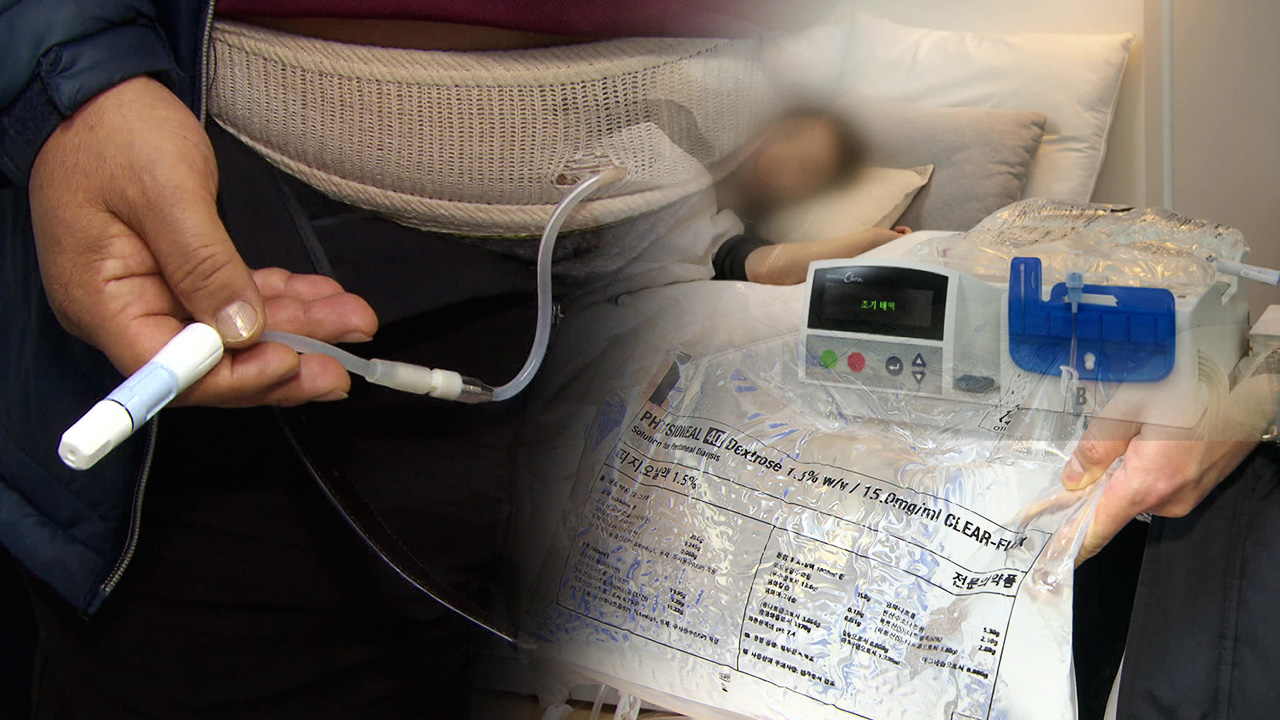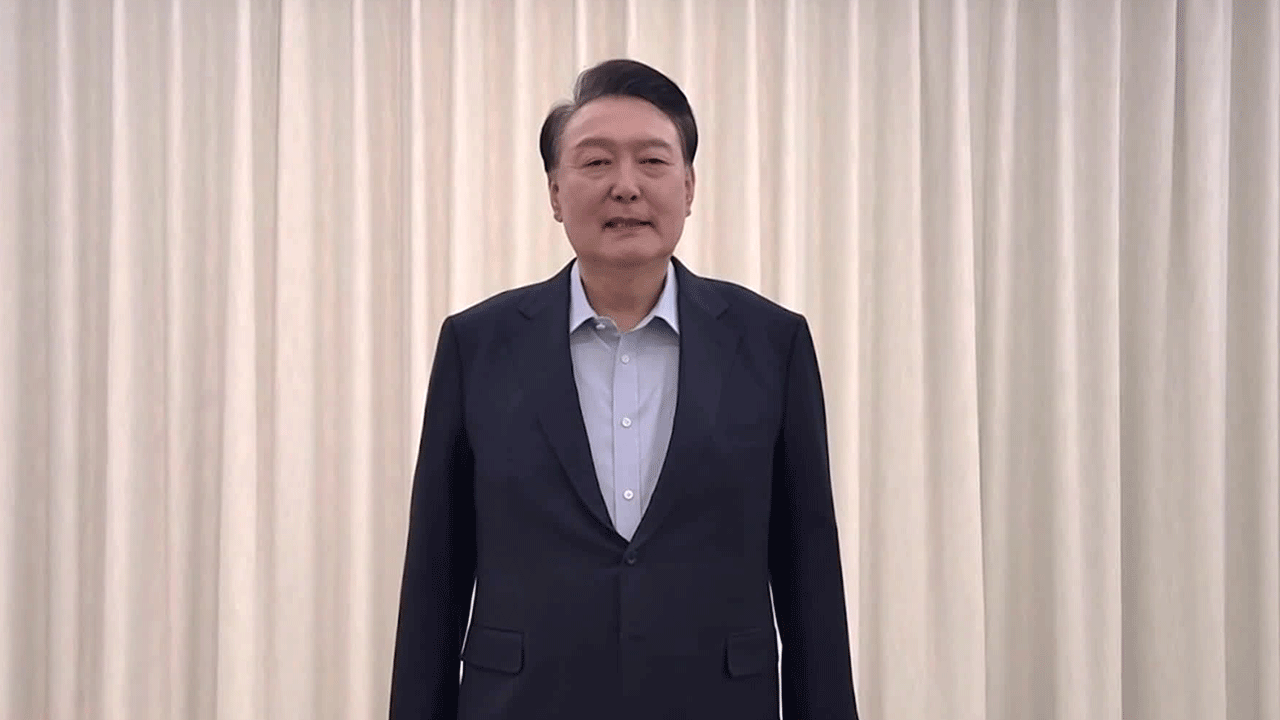[Anchor]
For patients whose kidney function has significantly declined and are undergoing dialysis, frequent hospital visits can be quite inconvenient.
There is a peritoneal dialysis treatment that can be done while sleeping at home, but it is still not widely utilized.
Why is that? Medical reporter Lee Chung-heon has investigated.
[Report]
Kim Gwi-hwa, a taxi driver, has been suffering from chronic kidney disease for the past 10 years.
After being infected with COVID-19 two years ago, his kidney function rapidly declined, leading him to start peritoneal dialysis.
Unlike hemodialysis, which requires frequent hospital visits, peritoneal dialysis can be done easily and conveniently at home.
[Kim Gwi-hwa/Peritoneal Dialysis Patient: "It doesn't interfere with my work. I can work without any hindrance or difficulty. That's the advantage, and I don't have to take extra time out."]
Peritoneal dialysis involves inserting a tube into the abdomen to infuse and drain dialysis fluid, removing waste through the peritoneum.
In particular, if you connect an automatic peritoneal dialysis machine before going to sleep, dialysis is automatically performed for 8 hours overnight.
When you wake up in the morning and disconnect the machine, you can move freely, allowing for almost no restrictions on social activities.
[Oh Guk-hwan/Professor of Nephrology, Seoul National University Hospital: "Peritoneal dialysis is fundamentally a self-administered dialysis method at home, so patients learn to manage their own dialysis schedule..."]
In fact, the participation rate of peritoneal dialysis patients in economic activities is 61%, which is much higher than that of hemodialysis patients.
However, peritoneal dialysis patients account for only 7.8% of all dialysis patients.
This is due to its lower recognition compared to hemodialysis and significantly lower medical fees available.
The government is conducting a home management pilot project to increase peritoneal dialysis, and experts advise that improving the compensation system for medical staff is essential.
This is KBS News, Lee Chung-heon.
For patients whose kidney function has significantly declined and are undergoing dialysis, frequent hospital visits can be quite inconvenient.
There is a peritoneal dialysis treatment that can be done while sleeping at home, but it is still not widely utilized.
Why is that? Medical reporter Lee Chung-heon has investigated.
[Report]
Kim Gwi-hwa, a taxi driver, has been suffering from chronic kidney disease for the past 10 years.
After being infected with COVID-19 two years ago, his kidney function rapidly declined, leading him to start peritoneal dialysis.
Unlike hemodialysis, which requires frequent hospital visits, peritoneal dialysis can be done easily and conveniently at home.
[Kim Gwi-hwa/Peritoneal Dialysis Patient: "It doesn't interfere with my work. I can work without any hindrance or difficulty. That's the advantage, and I don't have to take extra time out."]
Peritoneal dialysis involves inserting a tube into the abdomen to infuse and drain dialysis fluid, removing waste through the peritoneum.
In particular, if you connect an automatic peritoneal dialysis machine before going to sleep, dialysis is automatically performed for 8 hours overnight.
When you wake up in the morning and disconnect the machine, you can move freely, allowing for almost no restrictions on social activities.
[Oh Guk-hwan/Professor of Nephrology, Seoul National University Hospital: "Peritoneal dialysis is fundamentally a self-administered dialysis method at home, so patients learn to manage their own dialysis schedule..."]
In fact, the participation rate of peritoneal dialysis patients in economic activities is 61%, which is much higher than that of hemodialysis patients.
However, peritoneal dialysis patients account for only 7.8% of all dialysis patients.
This is due to its lower recognition compared to hemodialysis and significantly lower medical fees available.
The government is conducting a home management pilot project to increase peritoneal dialysis, and experts advise that improving the compensation system for medical staff is essential.
This is KBS News, Lee Chung-heon.
■ 제보하기
▷ 카카오톡 : 'KBS제보' 검색, 채널 추가
▷ 전화 : 02-781-1234, 4444
▷ 이메일 : kbs1234@kbs.co.kr
▷ 유튜브, 네이버, 카카오에서도 KBS뉴스를 구독해주세요!
- Support for peritoneal dialysis
-
- 입력 2025-01-19 01:13:18

[Anchor]
For patients whose kidney function has significantly declined and are undergoing dialysis, frequent hospital visits can be quite inconvenient.
There is a peritoneal dialysis treatment that can be done while sleeping at home, but it is still not widely utilized.
Why is that? Medical reporter Lee Chung-heon has investigated.
[Report]
Kim Gwi-hwa, a taxi driver, has been suffering from chronic kidney disease for the past 10 years.
After being infected with COVID-19 two years ago, his kidney function rapidly declined, leading him to start peritoneal dialysis.
Unlike hemodialysis, which requires frequent hospital visits, peritoneal dialysis can be done easily and conveniently at home.
[Kim Gwi-hwa/Peritoneal Dialysis Patient: "It doesn't interfere with my work. I can work without any hindrance or difficulty. That's the advantage, and I don't have to take extra time out."]
Peritoneal dialysis involves inserting a tube into the abdomen to infuse and drain dialysis fluid, removing waste through the peritoneum.
In particular, if you connect an automatic peritoneal dialysis machine before going to sleep, dialysis is automatically performed for 8 hours overnight.
When you wake up in the morning and disconnect the machine, you can move freely, allowing for almost no restrictions on social activities.
[Oh Guk-hwan/Professor of Nephrology, Seoul National University Hospital: "Peritoneal dialysis is fundamentally a self-administered dialysis method at home, so patients learn to manage their own dialysis schedule..."]
In fact, the participation rate of peritoneal dialysis patients in economic activities is 61%, which is much higher than that of hemodialysis patients.
However, peritoneal dialysis patients account for only 7.8% of all dialysis patients.
This is due to its lower recognition compared to hemodialysis and significantly lower medical fees available.
The government is conducting a home management pilot project to increase peritoneal dialysis, and experts advise that improving the compensation system for medical staff is essential.
This is KBS News, Lee Chung-heon.
For patients whose kidney function has significantly declined and are undergoing dialysis, frequent hospital visits can be quite inconvenient.
There is a peritoneal dialysis treatment that can be done while sleeping at home, but it is still not widely utilized.
Why is that? Medical reporter Lee Chung-heon has investigated.
[Report]
Kim Gwi-hwa, a taxi driver, has been suffering from chronic kidney disease for the past 10 years.
After being infected with COVID-19 two years ago, his kidney function rapidly declined, leading him to start peritoneal dialysis.
Unlike hemodialysis, which requires frequent hospital visits, peritoneal dialysis can be done easily and conveniently at home.
[Kim Gwi-hwa/Peritoneal Dialysis Patient: "It doesn't interfere with my work. I can work without any hindrance or difficulty. That's the advantage, and I don't have to take extra time out."]
Peritoneal dialysis involves inserting a tube into the abdomen to infuse and drain dialysis fluid, removing waste through the peritoneum.
In particular, if you connect an automatic peritoneal dialysis machine before going to sleep, dialysis is automatically performed for 8 hours overnight.
When you wake up in the morning and disconnect the machine, you can move freely, allowing for almost no restrictions on social activities.
[Oh Guk-hwan/Professor of Nephrology, Seoul National University Hospital: "Peritoneal dialysis is fundamentally a self-administered dialysis method at home, so patients learn to manage their own dialysis schedule..."]
In fact, the participation rate of peritoneal dialysis patients in economic activities is 61%, which is much higher than that of hemodialysis patients.
However, peritoneal dialysis patients account for only 7.8% of all dialysis patients.
This is due to its lower recognition compared to hemodialysis and significantly lower medical fees available.
The government is conducting a home management pilot project to increase peritoneal dialysis, and experts advise that improving the compensation system for medical staff is essential.
This is KBS News, Lee Chung-heon.
-
-

이충헌 기자 chleemd@kbs.co.kr
이충헌 기자의 기사 모음
-
이 기사가 좋으셨다면
-
좋아요
0
-
응원해요
0
-
후속 원해요
0















이 기사에 대한 의견을 남겨주세요.